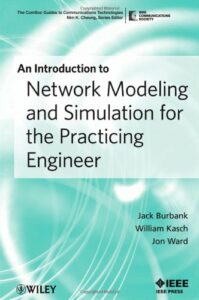| Book Name: | An Introduction to Network Modeling and Simulation for the Practicing Engineer |
| Category: | Telecommunication Books |
| Free Download: | Available |
Free PDF Download An Introduction to Network Modeling and Simulation for the Practicing Engineer

Book Description:
This book provides the practicing engineer with a concise listing of currently available commercial and open-source modeling and simulation tools, including examples of implementing those tools for solving specific Modeling and Simulation examples. Instead of focusing on the underlying theory of Modeling and Simulation and fundamental building blocks for custom simulations, this book compares platforms used in practice. It gives rules enabling the practicing engineer to utilize available Modeling and Simulation tools. This book will contain insights regarding common pitfalls in network Modeling and Simulation and practical methods for working engineers.
Table of contents :
AN INTRODUCTION TO NETWORK MODELING AND SIMULATION FOR THE PRACTICING ENGINEER……Page 5
CONTENTS……Page 7
PREFACE……Page 9
ACKNOWLEDGMENTS……Page 11
ABOUT THE AUTHORS……Page 13
CHAPTER 1: Introduction……Page 15
1.1 ADVANTAGES AND DISADVANTAGES OF MODELING AND SIMULATION……Page 20
1.2 COMPARISON OF “HOMEBREW” MODELS AND SIMULATION TOOLS……Page 22
1.3 COMMON PITFALLS OF MODELING AND SIMULATION AND RULES OF THUMB……Page 23
1.4 AN OVERVIEW OF COMMON M&S TOOLS……Page 30
1.5 AN OVERVIEW OF THE REST OF THIS BOOK……Page 32
CHAPTER 2: Modeling and Simulation for RF Propagation……Page 34
2.1 THE FADING CHANNEL……Page 36
2.2 THE ITU M.1225 MULTIPATH FADING PROFILE FOR MOBILE WiMAX……Page 52
2.3 PRACTICAL FADING MODEL IMPLEMENTATIONS—WiMAX EXAMPLE……Page 56
2.4 RF PROPAGATION SIMULATORS……Page 59
2.5 PROPAGATION AND FADING SIMULATIONS—LESSONS LEARNED……Page 62
CHAPTER 3: Physical Layer Modeling and Simulation……Page 65
3.1 INCORPORATING INTERFERENCE INTO A MODEL……Page 66
3.2 THE IMPORTANCE OF A PREAMBLE……Page 73
3.3 PRACTICAL WIRELESS PHY MODEL IMPLEMENTATIONS……Page 76
3.4 WIRELESS NETWORK SIMULATION LESSONS LEARNED AND COMMON PITFALLS—PHY LAYER……Page 83
CHAPTER 4: Medium Access Control Modeling and Simulation……Page 86
4.1 MODELING AND SIMULATION OF WIRED MACs……Page 87
4.2 WIRELESS NETWORK MAC SIMULATION……Page 92
4.3 PRACTICAL MAC MODEL IMPLEMENTATIONS……Page 104
4.4 NETWORK SIMULATION LESSONS LEARNED AND COMMON PITFALLS—MAC LAYER……Page 106
5.1 NETWORK LAYER……Page 111
5.2 TRANSPORT AND APPLICATION LAYERS……Page 116
5.3 EXAMPLE OF HIGHER LAYER MODELING: TRANSPORT LAYER PERFORMANCE ANALYSIS……Page 119
5.4 EXAMPLE OF HIGHER LAYER MODELING: DETAILED NETWORK LAYER MODELING……Page 123
CHAPTER 6: Hardware-in-the-Loop Simulations……Page 128
6.1 ADVANTAGES AND DISADVANTAGES OF HITL APPROACHES……Page 132
6.2 NETWORK M&S HITL APPROACHES……Page 134
6.3 HITL EXAMPLES……Page 140
6.5 NETWORK-LAYER HITL-READY NETWORK SIMULATION PLATFORMS……Page 153
6.6 HITL CONCLUSION……Page 156
CHAPTER 7: Complete Network Modeling and Simulation……Page 157
7.2 IEEE HLA (1516)……Page 159
7.3 COMPLETE NETWORK SIMULATION EXAMPLES……Page 186
8.1 VERIFICATION AND VALIDATION……Page 194
8.2 DATA VISUALIZATION AND INTERPRETATION……Page 199
CHAPTER 9: Network Modeling and Simulation: Summary……Page 200
REFERENCES……Page 202
INDEX……Page 210
An Introduction to Network Modeling and Simulation for the Practicing Engineer (The ComSoc Guides to Communications Technologies) PDF
Author(s): Jack Burbank, William Kasch, Jon Ward
Series: The ComSoc Guides to Communications Technologies
Publisher: Wiley-IEEE Press, Year: 2011
ISBN: 0470467266,9780470467268









![[PDF] Draw Buildings and Cities in 15 Minutes Draw Buildings and Cities in 15 Minutes pdf](https://www.freepdfbook.com/wp-content/uploads/2021/06/Draw-Buildings-and-Cities-in-15-Minutes-218x150.jpg)








![[PDF] Digital Image Processing An Algorithmic Introduction Using Java Digital Image Processing An Algorithmic Introduction Using Java](https://www.freepdfbook.com/wp-content/uploads/2022/06/Digital-Image-Processing-An-Algorithmic-Introduction-Using-Java.jpg)




![[PDF] 43 Years JEE ADVANCED + JEE MAIN Chapterwise & Topicwise Solved Papers 43 Years JEE ADVANCED (1978-2020) + JEE MAIN Chapterwise & Topicwise Solved Papers Physics PDF](https://www.freepdfbook.com/wp-content/uploads/2022/03/43-Years-JEE-ADVANCED-1978-2020.jpg)

![[PDF] Problems in Physical Chemistry for JEE (Main & Advanced) Problems in Physical Chemistry for JEE (Main & Advanced) Free PDF Book Download](https://www.freepdfbook.com/wp-content/uploads/2022/03/Problems-in-Physical-Chemistry-for-JEE-Main-Advanced.jpg)
![[PDF] Engineering Physics (McGraw Hill)](https://www.freepdfbook.com/wp-content/uploads/2021/05/bafc8c2685bb6823a9c56134f7fba5df.jpeg)

![[PDF] Engineering Chemistry By Shashi Chawla](https://www.freepdfbook.com/wp-content/uploads/2022/05/Theory-And-Practicals-of-Engineering-Chemistry-By-Shashi-Chawla-free-pdf-book.jpeg)
![[PDF] Chemistry: An Introduction to Organic, Inorganic & Physical Chemistry Chemistry: An Introduction to Organic, Inorganic & Physical Chemistry](https://www.freepdfbook.com/wp-content/uploads/2022/04/Chemistry-An-Introduction-to-Organic-Inorganic-Physical-Chemistry.jpg)
![[PDF] Essentials of Physical Chemistry Essentials of Physical Chemistry Free PDF Book by Bahl](https://www.freepdfbook.com/wp-content/uploads/2022/04/Essentials-of-Physical-Chemistry-bahl.jpg)
![[PDF] Biological control of plant-parasitic nematodes: soil ecosystem management in sustainable agriculture Biological control of plant-parasitic nematodes: soil ecosystem management in sustainable agriculture](https://www.freepdfbook.com/wp-content/uploads/2022/05/Biological-control-of-plant-parasitic-nematodes-soil-ecosystem-management-in-sustainable-agriculture.jpg)
![[PDF] Human Anatomy: Color Atlas and Textbook Human Anatomy: Color Atlas and Textbook Free PDF Book](https://www.freepdfbook.com/wp-content/uploads/2022/05/Human-Anatomy-Color-Atlas-and-Textbook.jpg)
![[PDF] Concepts of Biology Book [Free Download]](https://www.freepdfbook.com/wp-content/uploads/2022/05/Concepts-of-Biology.jpg)
![[PDF] Essentials of Biology [Free Download] Essentials of Biology Free PDF BOok Download](https://www.freepdfbook.com/wp-content/uploads/2022/05/Essentials-of-Biology-Free-PDF-Book-Downlaod.jpg)
![[PDF] Human Biology Book [Free Download]](https://www.freepdfbook.com/wp-content/uploads/2022/05/PDF-Human-Biology-Book-Free-Download.jpg)


